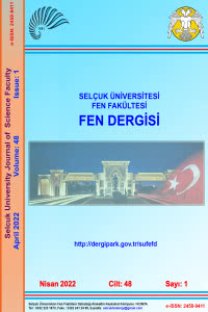HHO HÜCRE PERFORMANSININ BULANIK MANTIK YÖNTEMİ İLE BELİRLENMESİ
Fuzzy Logic Modeling of Performance HHO Dry Cell
___
- Ata, S., 2015, PEM Yakıt Hücresinin Membran Performansının Deneysel Olarak İncelenmesi ve Enerji Ayrışımı Olayının Bulanık Mantık Yöntemi ile Modellenmesi, Yüksek Lisans Tezi, Selçuk Üniversitesi, Fen Bilimleri Enstitüsü, Konya.
- Ata, S., Dincer, K., 2015a, "Anot Tarafı Karbon Nanotüp İle Kaplanmış PEM Yakıt Hücresi Performansının Bulanık Mantık Yöntemiyle Modellenmesi", Ulusal Hidrojen Teknolojileri Kongresi UHTEK-2015, İstanbul, Aralık 2015.
- Ata, S., Dincer, K.2015b, "Rule-based Mamdani-type fuzzy modeling of performance proton exchange membrane fuel cell with carbon nanotube", 15th International Multidisciplinary Scientific GeoConference SGEM 2015, Bulgaria, June 2015.
- Berber, A., Dincer, K., Yılmaz, Y., Ozen, D.N., 2013, "Rule-based Mamdani-type fuzzy modeling of heating and cooling performances of counter-flow Ranque Hilsch vortex tubes with different geometric construction for steel", Energy, Vol.51, pp. 297-304.
- Bhardwaj, S., Verma, A.S., Sharma, S.K., 2014, "Effect of Brown Gas on The Performance of A Four Stroke Gasoline Engine", International Journal of Emerging Technology and Advanced Engineering, Vol.4, No.1, pp.300-307.
- Cameron, R., 2012, Effects of On-board HHO and Water Injection in a Diesel Generator, Bachelor of Engineering Research Project, University of Southern Queensland Faculty of Engineering and Surveying.
- Chakrapani, K., Neelamegam, P., 2011, "Optimization of Fuel Consumption using HHO in HDL Technique Verified in FPGA", Journal of Theoretical and Applied Information Technology, Vol.31, No.2, pp.140-145.
- Dincer, K., Ongun, R., Dede, O., 2013, "HHO Hücresinin Performansının Deneysel Olarak Incelenmesi", Selçuk Üniversitesi Journal of Technical-Online, Vol.12, No.3, pp.66-75.
- Gao, D., Jin, Z., Lu, Q., 2008, "Energy Management Strategy Based on Fuzzy Logic for a Fuel Cell Hybrid Bus," Journal of Power Sources, Vol.185, pp.311-317.
- Gülcan, B.2012. Bulanık Doğrusal Programlama ve Bir Bisküvi İşletmesinde Optimum Ürün Formülü Oluşturma, Yüksek Lisans Tezi, Karamanoğlu Mehmetbey Üniversitesi Sosyal Bilimler Enstitüsü, Karaman.
- Hasgül, Ö., Anagün, A.S., 2005, "Deneysel Sonuçların Analizinde Yapay Sinir Ağları Kullanımı ve Beton Dayanım Testi İçin Bir Uygulama", V. Ulusal Üretim Araştırmaları Sempozyumu, İstanbul.
- Keshwani, D.R., Jones, D.D., Meyer G.E.R., Brand, M., 2008, "Rule-based Mamdani-type Fuzzy Modeling of Skin Permeability", Applied Soft Computing, Vol.8, pp. 285-294.
- Leelakrishnan, E., Lokesh, N., Suriyan, H., 2013, "Performance and Emission Characteristics of Brown's Gas Enriched Air in Spark Ignition Engine", International Journal of Innovative Research in Science, Engineering and Technology, Vol.2, No.2, pp.393-404.
- Madyira, D, Harding, W., 2014, "Effect of HHO on Four Stroke Petrol Engine Performance", 9th South African Conference on Computational and Applied Mechanics, Somerset West.
- Önal, G., Dincer, K., Yayla, S., Yılmaz, Y., Ersoyoğlu, A., S.2015, "Pt/C Coating for Proton Exchange Membrane Fuel Cell (PEMFC) and Rule-Based Mamdani-Type Fuzzy Modeling of PEMFC Performance", International Journal of Mining, Metallurgy & Mechanical Engineering, Vol.3, No.3, pp.122-128.
- Özek, A., Sinecen, M., 2004, "Klima Sistem Kontrolünün Bulanık Mantık ile Modellemesi", Pamukkale Üniversitesi Mühendislik Bilimleri Dergisi, Vol. 10, No. 3, pp.353-358.
- Sakthıvel, S., 2014, "An Experimental Assessment of Performance and Exhaust Emission Characteristics by Addition of Hydroxy (HHO) Gas in Twin Cylinder C.I. Engine", International Journal of Innovative Research in Science, Engineering and Technology, Vol.3, No.2, pp.60-65.
- Shakhawat, C., Tahir, H., Neil, B., 2006, "Fuzzy Rule-based Modelling for Human Health Risk from Naturally Occurring Radioactive Materials in Produced Water", Journal of Environmental Radioactivity, Vol.89, pp.1-17.
- Tektaş, M., 2010, Web Tabanlı Yapay Zeka Teknikleri Eğitim Simülatörlerinin Hazırlanması, Marmara Üniversitesi BAP Komisyonu Başkanlığı Proje Raporu, pp.76-90.
- Tiryaki, A.E., Kazan, R., 2007, "Bulaşık Makinesinin Bulanık Mantık ile Modellenmesi", Mühendis ve Makine, Vol. 48, sayı 565, pp.3-8.
- Tong, S.W., Qian, D.W., Fang, J.J., Li, H.X., 2003, "Integrated Modeling and Variable Universe Fuzzy Control of a Hydrogen-Air Fuel Cell System", International Journal of Electrochemical Science, Vol.8, pp.3636-3652.
- Tosun, M., Dincer, K., Baskaya, S., 2011, "Rule-based Mamdani-type Fuzzy Modelling of Thermal Performance of Multi-Layer Precast Concrete Panels used in Residential Buildings in Turkey", Expert Systems with Applications, Vol.38, pp.5553-5560.
- Yadav, M.S., Sawant, S.M., 2011, "Investigations on Oxyhydrogen Gas and Producer Gas as alterntive Fuels on The Performance of Twin Cylinder Diesel Engine", International Journal of Mechanical Engineering and Technology (IJMET), Vol.2, No.2, pp.85-98.
- Yıldız, Ş., Kişoğlu, S., 2011, "Bulanık Mantık Yaklaşımı ile Hazır Giyimde Beden Numarası Belirleme", E-Journal of New World Sciences Academy, Vol.6, No.1, pp.12-22.
- Yılmaz, A., Ayan, K., 2013, "Cancer Risk Analysis by Fuzzy Logic Approach and Performance Status of The Model", Turkish Journal of Electrical Engineering & Computer Sciences, TÜBİTAK, Vol.21, pp.897-912.
- ISSN: 2147-9364
- Yayın Aralığı: 2
- Başlangıç: 2013
- Yayıncı: Selçuk Üniversitesi Mühendislik Fakültesi
TREATMENT ALTERNATIVES FOR MICROPOLLUTANT REMOVAL IN WASTEWATER
BİLGEHAN NAS, TAYLAN DOLU, HAVVA ATEŞ, M.Emin ARGUN, ESRA YEL
DETERMINATION OF EQUIVALENT CIRCUIT PARAMETERS OF INDUCTION MOTORS BY USING HEURISTIC ALGORITHMS
STATISTICALLY GUIDED ARTIFICIAL BEE COLONY ALGORITHM
HHO HÜCRE PERFORMANSININ BULANIK MANTIK YÖNTEMİ İLE BELİRLENMESİ
SADIK ATA, GÜROL ÖNAL, KEVSER DİNCER
ACİL DURUM HABERLEŞMESİNDE KULLANILAN EL TELSİZİNİN ÇOK ÖLÇÜTLÜ KARAR VERME YÖNTEMLERİ İLE SEÇİLMESİ
Atiye Zeynep KÜTÜKCÜ, TAMER EREN
ALİ ULVİ, Ahmet Suad TOPRAK, MURAT YAKAR
EXAMINING PERFORMANCE OF STABILIZATION PONDS OF AHVAZ'S SLAUGHTERHOUSE
